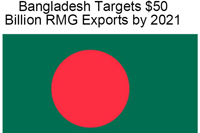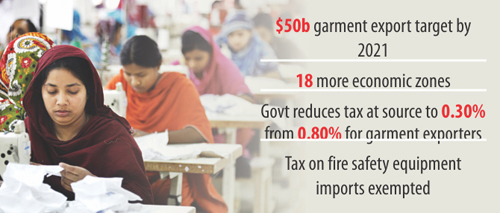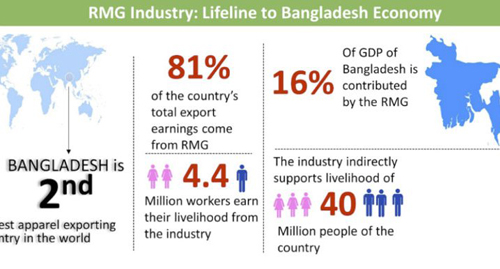
Set by the garment industry of Bangladesh in 2014, the slogan to reach ‘Fifty by Twenty One’ has gained momentum. In December 2016, at a seminar organised by BGMEA titled ‘Taking Bangladesh Apparel Sector Forward’, the state minister for foreign affairs Shahriar Alam had shared this statement. Last fiscal, from July 2015 to June 2016, the country’s garments exports touched $28.09 billion whereas in the calendar year ending in December 2016, exports were $28.67 billion. To reach the target of $50 billion in 2021, the export rate needs to grow at a 12.25 per cent cumulative rate. Past growth rates have been in double digits, but given the current global economic and trade environment, whether it is possible for Bangladesh to continue notching up double-digit growth rates is doubtful.
Growth impediments
A ESCAP report say, price growth of export goods of Bangladesh will decline in 2017 compared to the current year but volume will increase significantly. While this report, Asia-Pacific Trade and Investment Report 2016, considered all exports, the prospect for RMG falls into the general mould of declining prices. At a recent conference at Harvard organised by ISDI, all stakeholders including representatives from buyers and labour unions agreed the price of clothing has been declining in recent years. And, the downward pressure on price, from the demand side, has been two-fold: consumers are now buying more high-end products and apparel and footwear sellers are losing consumer dollars to healthcare, rent, home-related products, electronics and cars. Another reason for the lower price is with greater prosperity, it basic needs such as food and clothing have low income and price elasticity.

Measures to boost exports
There are many aspects, which include marketing, engineering, management, and economic tools, to raise the price of RMG and are well-known, the ultimate goal is not easy to accomplish. In line with this, commerce minister Tofail Ahmed last month urged labour bodies to press buyers to raise RMG prices. Ahmed urged union leaders to connect with their counterparts in importing countries to use their influence on buyers and consumers. He said labour organisations of the RMG sector should tell buyers to raise product prices, which would help increase labour wages in the sector. There are four economic ways to boost exports: quantity, price, changing product mix and exchange rate manipulation.
The industry can also boost of profitability, without increasing prices, by increasing productivity and efficiency. Ironically, readymade garments exporters have recently demanded higher cash incentives and devaluation of taka against the US dollar. The association also demanded apparel factories should be exempted from 1as price hike that the government planned to implement from January 2017. A lower cost of borrowing will also help exporters improve profit margins.
In the years to come, to retain market share in the low-cost-and-high-efficient region, the path to profitability and export growth is increased efficiency, higher productivity, and quality management. The global apparel market is valued at $3 trillion, and between 2007 and 2013, the market increased with average annual growth of 5.1 per cent. Year 2017 is expectd to be a stable year for apparel retail. A report released by Moody's in mid-December said, the sector can expect sales growth of 6 to 8 per cent, led primarily by direct-to-consumer channels and international growth. However, the same report anticipates apparel and footwear sellers will lose consumer dollars to healthcare, rent, home-related products, electronics and cars. In addition, traffic is expected to be weak throughout the year, with department stores and larger retailers such as Walmart bearing the brunt of that decline.
To channelise efforts in the right direction, BGMEA and Danish Fashion and Textile Industry Associations recently launched the ‘Step Up Project’ to improve productivity and address social and environmental challenges in the country's RMG sector. A similar initiative is needed to move up the value chain by using business processes and resources to export higher-margin products. There is a need to explore new markets in Latin America, Africa and the Commonwealth countries.












